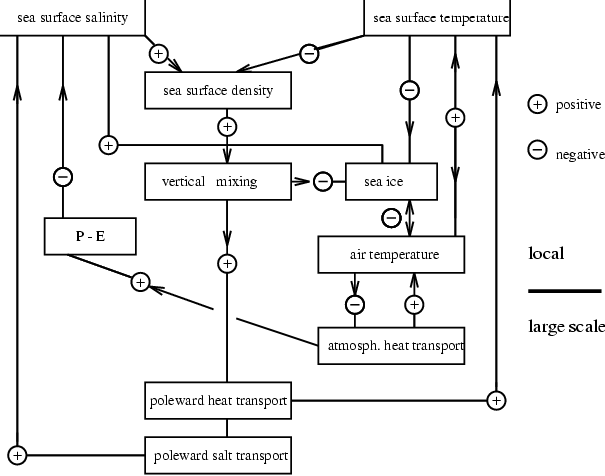
Lohmann, G., and Gerdes, R., 1998, J. Climate 11, 2789-2803.
We investigate the sensitivity of the thermohaline circulation (THC) with respect to a subpolar salinity perturbation. Such perturbation simulates a fresh water release caused by retreating glaciers or anomalous sea ice. The feedback mechanisms amplifying or damping the initial anomaly are analyzed in the coupled ocean-atmosphere-sea ice model. Their understanding is essential for modelling climate variability on decadal and longer time scales.
A 3-D ocean circulation model is coupled to an atmospheric energy balance and a thermodynamic sea ice model. The perturbation in the North Atlantic's subpolar salinity causes a cessation of deep convection and a climate state with decreased oceanic heat transport, decreased high latitude atmospheric temperature, and larger sea ice extent. The sea ice isolates the atmosphere from the warmer ocean reducing the heat flux and thus the vertical mixing in the ocean. This change in the local buoyancy flux is responsible for a reduced large-scale circulation. This change in the local buoyancy flux weakens the large scale circulation. High latitude cooling can not compensate for the freshening since the ocean temperature can not fall below the freezing point. Because deep convection is suppressed where sea ice is present, North Atlantic deep water formation is rather sensitive to the formation of sea ice. The insulating effect of sea ice is more important than its impact on salinity in our experiments. Different types of boundary conditions are used to isolate relevant feedback processes. The stability of the THC depends crucially on the atmospheric model component. Active atmospheric heat transport allows continued deep water formation because the sea ice margin is shifted poleward.
-> available as plain PostScript file (HUGE !)
Reference State
Minimal overturning after 14 years
.
Development after the perturbation in the coupled model
.
Feedback mechanisms
.